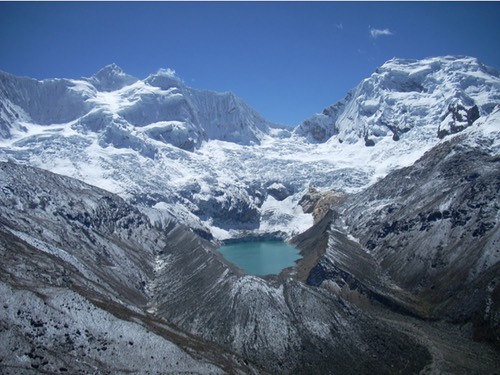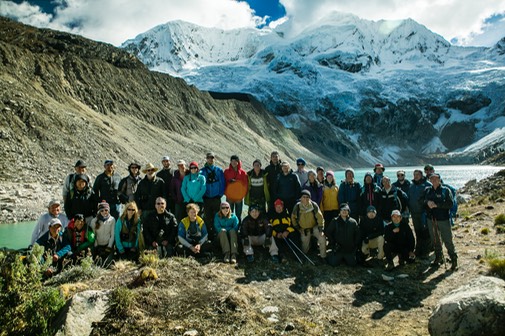
Palcacocha Lake (Photo: Colette Simonds)
Researchers from the Center for Research in Water Resources (CRWR) at The University of Texas at Austin are engaged in a program of developing water management tools for use in the Rio Santa basin of Peru. The research is focused on developing adaptation strategies for basin stakeholders to deal with climate change impacts on water resources and security in this glacier dominated basin.
This research has been supported by the US Agency for International Development (USAID), the Fulbright Program and greatly facilitated by The Mountain Institute. Some of the results of this research are available at the links listed below.
Securing Mountain Water and Livelihoods
We are starting a new thee-year project in Peru. The USAID financed Securing Mountain Water and Livelihoods project,implemented by The Mountain Institute and the University of Texas at Austin, will help achieve the goal of climate resilient development in highland Ancash, Peru. The project will focus on advancing the development goals of rural stakeholders affected by climate change. It will support local groups with the potential to improve their economic competitiveness and build climate resilient pathways. The project will also create sustainable synergies and partnerships between the national university system (which can provide generations of trained staff) and municipal commonwealths (a mechanism to reach larger territories and populations and to access public funds). The project will also support grassroots communities by scaling up existing donor-funded projects with participatory farmer research groups. The project will address the vulnerabilities high mountain communities in Peru face from climate change and to incorporate proven adaptation measures to advance the project’s objectives.
The project will engage the faculty, administration and students of the Universidad Nacional Santiago Antúnez de Mayolo (UNASAM) to produce a self-assessment of their current development activities in the Ancash Region and facilitate communication with other universities with advanced programs in climate change adaptation, including the Pontificia Universidad Católica del Perú (PUCP) RP-GIRH graduate program, the Universidad Nacional Mayor de San Marcos (UNMSM) PEER and other projects, and the Universidad Nacional Agraria La Molina (UNALM) Range Land Management Laboratory to foster cooperation in applied research and training. The project will provide UNASAM faculties with technical assistance to prepare institutional development plans for their University Extension Service. Through initial activities with the Department of Environmental Sciences, other faculty in the Department of Agronomy and Economy will be invited to participate. The result will be the empowerment of a new generation of professionals with skills in climate change adaptation in rural areas. In addition, UNASAM will have improved mechanisms to provide extension services to the peasant communities of Ancash in cooperation with regional and local governments.
High Mountains Adaptation Partnership
The aim of the High Mountains Adaptation Partnership is to increase awareness for the critical importance of high mountain glacial watersheds globally in the context of climate change, highland-lowland interactions, and ecosystem services. This will be achieved through the development of innovative high mountain tools, approaches, and the establishment of a unique high mountain Community of Practice. The Program will create enabling conditions necessary for local communities, governments, and stakeholders living in and/or dependant on high glacial watersheds to (a) build resilience to the impacts of climate change, (b) advance scientific knowledge of high mountain systems and processes, and (c) increase global awareness and support for the critical importance of high mountain glacial environments.
Click here for more information
Cordillera Blanca, July 2012
In July 2012, TMI and the University of Texas at Austin returned to the Cordillera Blanca in Peru to continue work on dangerous lakes and glacier recession (Lake Palcacocha and the Pastaruri Glacier). We conducted field surveys to characterize the risk posed by the glacial lake and the mass balance of the glacier.
Cordillera Blanca, July 2013
In July 2013, The High Mountain Glacial Watershed Program organized field work and hosted an international conference in Huaraz and the Cordillera Blanca, Peru. In the workshop, there were more than 35 scientists, planners, and citizens from over 12 countries. Two days of conference room presentations were followerd by 3 days of field training modules and then a 3 day trek to explore on of the most dangerous glacial lakes in Peru, Laguna Palcacocha.

Group photo of Glacial Flooding and Disaster Risk Management Knowledge Exchange and Field Training, July 11-24, 2013, Huaraz, Peru
(http://highmountains.org/blog/photos-peru-2013-high-mountains-workshop)
Video (https://vimeo.com/77387853)
For more information, contact Dr. Daene McKinney at: daene@aol.com.
"Desolation"
[13 December 1941]
From Cojup, desolating, came the treacherous death.
Heaven dressed in gray that tragic morning;
fearless and sovereign, the reaper sowed mourning.
From Cojup, desolating, came the treacherous death.
Frightening at early time. . .
As the murderer comes, the raging death came that tragic morning.
Parents, siblings, friends, sweet girlfriends gone forever:
of lost loved ones, boulders mute witnesses.
From Cojup, desolating, came the treacherous death.
Orchards turned into wildernesses by an implacable destiny. . .
Facing the inscrutable mystery only a sick people stays.
From Cojup, desolating, came the treacherous death.
13/12/52 (Thanks to Steve Wegner)